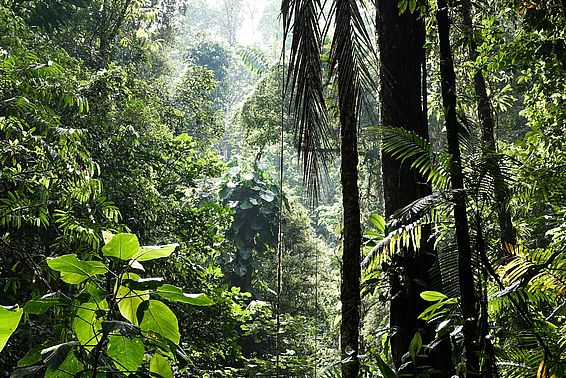27.09.2023 | Stephanie Kusma | WSL News
Biodiversity is greatest in the tropics. That fact that it is hot and humid there plays an important role. However, climate alone cannot explain the global biodiversity patterns well. Researchers at the Swiss Federal Institute for Forest, Snow and Landscape Research have now tackled this old problem from a completely different angle - and identified a new, doubly important reason for high tropical diversity.
No one knows exactly why many species live in the tropical rainforest. According to a frequently quoted estimate, it is two-thirds of the world's total; a recent study found that for terrestrial vertebrates - amphibians, reptiles, birds and mammals - it is over 60 per cent. What is clear is that biodiversity is greatest in the tropics and declines towards the poles. Experts call this phenomenon the "latitudinal biodiversity gradient". It has been known for over 200 years.
For just as long have researchers been looking for explanations of these global biodiversity patterns. Tropical environments are ancient allowing for the accumulation of species over time. The tropics also occupy a particularly large area compared to other climate zones - a lot of space, enough capacity and many different habitats for a large number of different species. One of the most important factors, however, is presumed to be the warm and humid climate of the tropics, in which biological processes take place particularly quickly, which knows neither summer nor winter break and is therefore very productive.
"But it was not clear whether the species richness in the tropics was primarily due to the climate or whether the large area and isolation of the region played a greater role," says Catherine Graham of the Swiss Federal Institute for Forest, Snow and Landscape Research WSL. In their search for an answer, WSL researcher Marco Túlio Pacheco Coelho and his colleagues turned the usual approach to this question on its head - and were suddenly able to explain the global species richness patterns much better than had previously been possible.
The geography of climate

Taking a fresh approach, the researchers cataloged the distinct climatic conditions that span our planet. In this exploration, they meticulously recorded the presence of various species, ranging from birds and mammals to amphibians and reptiles, that thrive in these specific climate conditions. A cornerstone of their analysis was quantifying the geographical size and isolation of regions on earth that have identical climate conditions. While certain climatic conditions stretch across broad regions, others appear more sporadically, akin to isolated pockets in a diverse climatic tapestry, echoing the nature of islands amidst a vast, varied ocean.
As expected, the analysis showed that warmth and humidity are important prerequisites for high biodiversity. "But twice as important is what we call the 'geography of climate': the isolation of regions with the same climatic conditions from each other and their total area," says Graham. If the total area of a climate condition was high, and the individual regions were isolated, species diversity under this climate condition was particularly high.
Analogy to language diversity
Coelho explains: "In mountain regions, dialects often differ from valley to valley because people are separated by the mountains between them. The same happens with plants and animals. If they live in isolated places, they grow and change in their own unique way." The highlight: "The land area of the tropics fulfils these conditions - there are large tropical rainforests on different continents," says Graham. And the biodiversity is also greatest there. The cooler regions of the higher latitudes, on the other hand, have less land area than the tropics, are better connected - and harbor significantly less species than the tropics.
The researchers therefore propose the "geography of climate" as an explanation for the latitudinal biodiversity gradient. But their results are not only of theoretical value: "They can be very useful for the future," says Coelho. For it is not only the climate that will change in the future, he says, but also the climate zones. "The questions are: If the climate zones were a jigsaw puzzle, would some pieces be more scattered and others closer together? Will their size change?" says the researcher. This can be answered with the new method, he adds. Coelho: "If we know how these puzzle pieces might shift, we can better prepare to protect life on our planet in a changing climate."
Contacts
Publication
Coelho, M.T.P., Barreto, E., Rangel, T.F. et al. (2023): The geography of climate and the global patterns of species diversity. Nature, https://www.nature.com/articles/s41586-023-06577-5
Copyright
WSL and SLF provide image and sound material free of charge for use in the context of press contributions in connection with this media release. The transfer of this material to image, sound and/or video databases and the sale of the material by third parties are not permitted.

